From Conflict to Cohesion: The analytical challenge in Southeast Asian Studies
Shamsul A.B.氏講演会
2011年6月15日 京都大学 東南アジア研究所
2011年6月15日に、マレーシア国民大学民族研究所長(Founding Director, Institute of Ethnic Studies, National University of Malaysia)のShamsul Amri Baharuddin氏をお招きして、御講演を頂きました。Shamsul氏は世界的にも知られる社会人類学・政治学の専門家であり、数々の国際的な賞を受賞されているだけでなく、マレーシア内外のマスメディアにおいてもしばしばコメンテーターを務められています。
今回は、2007年に自らも創設に尽力された民族研究所の紹介の後、そこで推進されている最新の研究をご報告いただきました。報告の中では、マレーシアの民族間関係をどのような視点でとらえるべきかについて、従来とは異なる理論的枠組みを提示され、民族の対立conflictではなく凝集性cohesionを捉えるための、新しい人類学を提唱されました。
マレーシアをはじめとする東南アジアの民族間関係については、これまで多くの社会科学者が言及してきましたが、そのほとんどは民族間の軋轢や対立をリスクと捉え、その調整や安定維持のために多大なコストを払わなければならないという実情を、ネガティブに捉えてきました。しかしShamsul氏は、たとえば日本が防災や減災、災害からの復旧・復興に膨大なコストを払い続けていることを引き合いに出しつつ、国家や国民の安全を維持するためにどの部分にコストをかけるのかは国によって事情が異なる、という主張もされました。つまり、民族間関係の調整にコストを払うことは国家として成熟していない「後進性」の現れであるかのように語ってきた従来の研究を批判し、新しい見方が必要とされていることを強調されたわけです。そして、これまでネガティブに見られてきた民族間関係についても、むしろそこには「安定的な緊張状態」があると捉え直し、それを裏付ける具体的事例を示しながら、cohesion approachという考え方を提案されました。
これまで、このような主張がなかったことが不思議なくらいですが、Shamsul氏のアイディアは、従来の研究に慣れ親しんでしまった我々には非常に新鮮であり、今後、ボルネオの民族間関係を考える上でも、多くのヒントが隠されている貴重な報告でした。
Shamsul氏による発表要旨は以下の通り:

Southeast Asia as a form of knowledge, as being presented in the field of Southeast Asian studies, popularized and expanded during the Cold War has privileged what could be called as a ‘conflict approach’ in which the workings of centrifugal forces as the ruling societal pattern informed analyses regarding the region and its component countries.
Underpinning this conflict approach was the well-known ‘domino theory.’ Therefore, each component country was perceived as a domino that would fall one after another as communism expanded its influence in the region, namely, from Mainland Southeast Asia (Vietnam, Laos, Cambodia, Thailand and Burma) to the Maritime part of the region (Malaysia, Indonesia, Singapore, Brunei and the Philippines).
Social scientists, working independently or for the noncommunist countries (USA, UK, France, Germany), held the viewpoint that the internal conflict and struggle within the region made it fragile and vulnerable to communist takeover. Saving the region from communist takeover became almost a ‘political salvation’ for both the noncommunist bloc and the majority of their social scientists. Although the Cold War was over in 1989, the conflict-based analytical paradigm persists until today. The countries of the region continued to be seen as fragile and vulnerable exposed to new transnational forces, such as global fundamental Islamic activism, that would find roots locally rather easily. Political analysts often playing the ‘prophet of doom’ role frequently offer negative predictions about the future of these societies. It was predicted once that the fall of Suharto would lead to the breaking down of Indonesian unity as a nation-state. Malaysia was predicted to suffer from serious bloody ethnic conflicts every time an economic crisis occurred in Asia. But none of these has actually taken place. Why it didn’t happen has also to be explained.
Perhaps, as this presentation shall argue, that it is useful to approach this issue sociologically from a ‘cohesion approach’ with the assumption that the plural societies in Southeast Asia are generally in a state of ‘stable tension’ meaning they have been surviving in a situation dominated by major societal contradictions but nonetheless, longitudinally, remains generally cohesive. In other words, there is social cohesion within these societies, but the journey has not been plain sailing. Empirical evidence from Malaysia shall be presented as a case study.

 Southeast Asia as a form of knowledge, as being presented in the field of Southeast Asian studies, popularized and expanded during the Cold War has privileged what could be called as a ‘conflict approach’ in which the workings of centrifugal forces as the ruling societal pattern informed analyses regarding the region and its component countries.
Underpinning this conflict approach was the well-known ‘domino theory.’ Therefore, each component country was perceived as a domino that would fall one after another as communism expanded its influence in the region, namely, from Mainland Southeast Asia (Vietnam, Laos, Cambodia, Thailand and Burma) to the Maritime part of the region (Malaysia, Indonesia, Singapore, Brunei and the Philippines).
Social scientists, working independently or for the noncommunist countries (USA, UK, France, Germany), held the viewpoint that the internal conflict and struggle within the region made it fragile and vulnerable to communist takeover. Saving the region from communist takeover became almost a ‘political salvation’ for both the noncommunist bloc and the majority of their social scientists. Although the Cold War was over in 1989, the conflict-based analytical paradigm persists until today. The countries of the region continued to be seen as fragile and vulnerable exposed to new transnational forces, such as global fundamental Islamic activism, that would find roots locally rather easily. Political analysts often playing the ‘prophet of doom’ role frequently offer negative predictions about the future of these societies. It was predicted once that the fall of Suharto would lead to the breaking down of Indonesian unity as a nation-state. Malaysia was predicted to suffer from serious bloody ethnic conflicts every time an economic crisis occurred in Asia. But none of these has actually taken place. Why it didn’t happen has also to be explained.
Perhaps, as this presentation shall argue, that it is useful to approach this issue sociologically from a ‘cohesion approach’ with the assumption that the plural societies in Southeast Asia are generally in a state of ‘stable tension’ meaning they have been surviving in a situation dominated by major societal contradictions but nonetheless, longitudinally, remains generally cohesive. In other words, there is social cohesion within these societies, but the journey has not been plain sailing. Empirical evidence from Malaysia shall be presented as a case study.
Southeast Asia as a form of knowledge, as being presented in the field of Southeast Asian studies, popularized and expanded during the Cold War has privileged what could be called as a ‘conflict approach’ in which the workings of centrifugal forces as the ruling societal pattern informed analyses regarding the region and its component countries.
Underpinning this conflict approach was the well-known ‘domino theory.’ Therefore, each component country was perceived as a domino that would fall one after another as communism expanded its influence in the region, namely, from Mainland Southeast Asia (Vietnam, Laos, Cambodia, Thailand and Burma) to the Maritime part of the region (Malaysia, Indonesia, Singapore, Brunei and the Philippines).
Social scientists, working independently or for the noncommunist countries (USA, UK, France, Germany), held the viewpoint that the internal conflict and struggle within the region made it fragile and vulnerable to communist takeover. Saving the region from communist takeover became almost a ‘political salvation’ for both the noncommunist bloc and the majority of their social scientists. Although the Cold War was over in 1989, the conflict-based analytical paradigm persists until today. The countries of the region continued to be seen as fragile and vulnerable exposed to new transnational forces, such as global fundamental Islamic activism, that would find roots locally rather easily. Political analysts often playing the ‘prophet of doom’ role frequently offer negative predictions about the future of these societies. It was predicted once that the fall of Suharto would lead to the breaking down of Indonesian unity as a nation-state. Malaysia was predicted to suffer from serious bloody ethnic conflicts every time an economic crisis occurred in Asia. But none of these has actually taken place. Why it didn’t happen has also to be explained.
Perhaps, as this presentation shall argue, that it is useful to approach this issue sociologically from a ‘cohesion approach’ with the assumption that the plural societies in Southeast Asia are generally in a state of ‘stable tension’ meaning they have been surviving in a situation dominated by major societal contradictions but nonetheless, longitudinally, remains generally cohesive. In other words, there is social cohesion within these societies, but the journey has not been plain sailing. Empirical evidence from Malaysia shall be presented as a case study.


